Montmartre
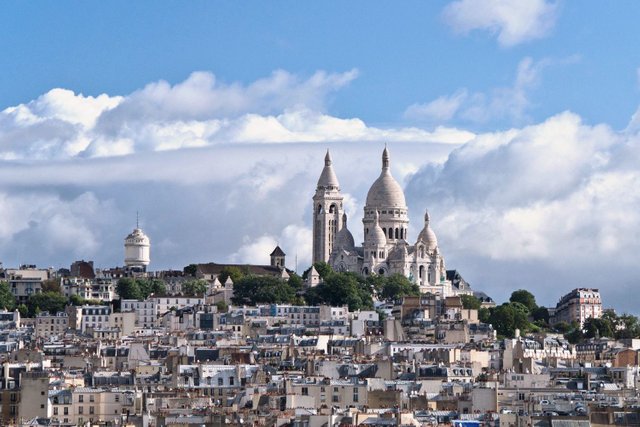
Is a large hill in Paris's 18th arrondissement. It is 130 m high and gives its name to the surrounding district, part of the Right Bank in the northern section of the city. The historic district established by the City of Paris in 1995 containing 60 ha. Montmartre is primarily known for its artistic history, the white-domed Basilica of the Sacré-Cœur on its summit, and as a nightclub district. The other, older, church on the hill is Saint Pierre de Montmartre, which claims to be the location at which the Jesuit order of priests was founded.
Near the end of the 19th century and at the beginning of the twentieth, during the Belle Époque, many artists had studios or worked in or around Montmartre, including Amedeo Modigliani, Claude Monet, Pierre-Auguste Renoir, Henri de Toulouse-Lautrec, Suzanne Valadon, Piet Mondrian, Pablo Picasso, Camille Pissarro, and Vincent van Gogh. Montmartre is also the setting for several hit films.
The toponym Mons Martis, Latin for "Mount of Mars", survived into Merovingian times, gallicised as Montmartre.[3]
History
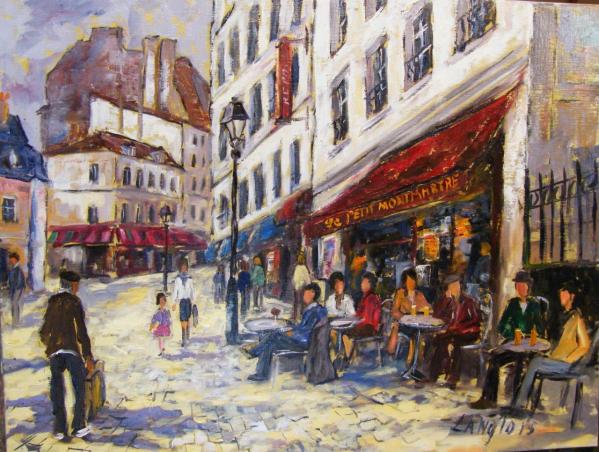
Archaeological excavations show that the heights of Montmartre were occupied from at least Gallo-Roman times. Texts from the 8th century cite the name of mons Mercori (Mount Mercury), and a 9th-century text speaks of Mount Mars. Excavations in 1975 north of the Church of Saint-Pierre found coins from the 3rd century and the remains of a major wall. Earlier excavations in the 17th century at the Fontaine-du-But (2 rue Pierre-Dac) found vestiges of Roman baths from the 2nd century.
The butte owes its particular religious importance to the text entitled Miracles of Saint-Denis, written before 885 by Hilduin, abbot of the monastery of Saint-Denis, which recounted how Saint Denis, a Christian bishop, was decapitated on the hilltop in 250 AD on orders of the Roman prefect Fescennius Sisinius for preaching the Christian faith to the Gallo-Roman inhabitants of Lutetia. According to Hilduin, Denis collected his head and carried it as far as the fontaine Saint-Denis, then descended the north slope of the hill, where he died. Hilduin wrote that a church had been built "in the place formerly called Mont de Mars, and then, by a happy change, 'Mont des Martyrs'."
In 1134, king Louis VI purchased the Merovingian chapel and built on the site the church of Saint-Pierre de Montmartre, still standing. He also founded The Royal Abbey of Montmartre, a monastery of the Benedictine order, whose buildings, gardens and fields occupied most of Montmartre. He also built a small chapel, called the Martyrium, at the site where it was believed that Saint Denis had been decapitated. It became a popular pilgrimage site. In the 17th century, a priory called abbaye d'en bas was built at that site, and in 1686 it was occupied by a community of nuns.
The abbey was destroyed in 1790 during the French Revolution, and the convent demolished to make place for gypsum mines. The church of Saint-Pierre was saved. At the place where the chapel of the Martyrs was located, an oratory was built in 1855. It was renovated in 1994.
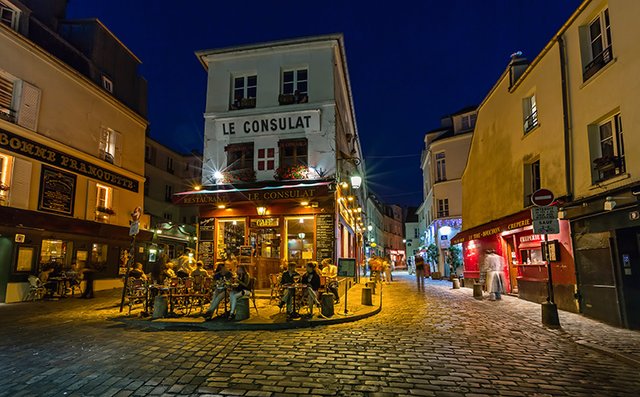
By the 15th century, the north and northeast slopes of the hill were the site of a village surrounded by vineyards, gardens and orchards of peach and cherry trees. The first mills were built on the western slope in 1529, grinding wheat, barley and rye. There were thirteen mills at one time, though by the late nineteenth century only two remained.
During the 1590 Siege of Paris, in the last decade of the French Wars of Religion, Henry IV placed his artillery on top of the butte of Montmartre to fire down into the city. The siege eventually failed when a large relief force approached and forced Henry to withdraw.
In 1790, Montmartre was located just outside the limits of Paris. That year, under the revolutionary government of the National Constituent Assembly, it became the commune of Montmartre, with its town hall located on place du Tertre, site of the former abbey. The main businesses of the commune were wine making, stone quarries and gypsum mines. The mining of gypsum had begun in the Gallo-Roman period, first in open air mines and then underground, and continued until 1860. The gypsum was cut into blocks, baked, then ground and put into sacks. Sold as 'montmartarite, it was used for plaster, because of its resistance to fire and water. Between the 7th and 9th centuries, most of the sarcophagi found in ancient sites were made of molded gypsum. In modern times, the mining was done with explosives, which riddled the ground under the butte with tunnels, making the ground very unstable and difficult to build upon. The construction of the Basilica of Sacré-Cœur required making a special foundation that descended 40 metres under the ground to hold the structure in place. A fossil tooth found in one of these mines was identified by Georges Cuvier as an extinct equine, which he dubbed Palaeotherium, the "ancient animal". His sketch of the entire animal in 1825 was matched by a skeleton discovered later.
The Basilica of the Sacré Cœur was built on Montmartre from 1876 to 1919, financed by public subscription as a gesture of expiation for the suffering of the city during the Franco-Prussian War and the 1871 Paris Commune. Its white dome is a highly visible landmark in the city, and near it artists set up their easels each day amidst the tables and colourful umbrellas of the place du Tertre.
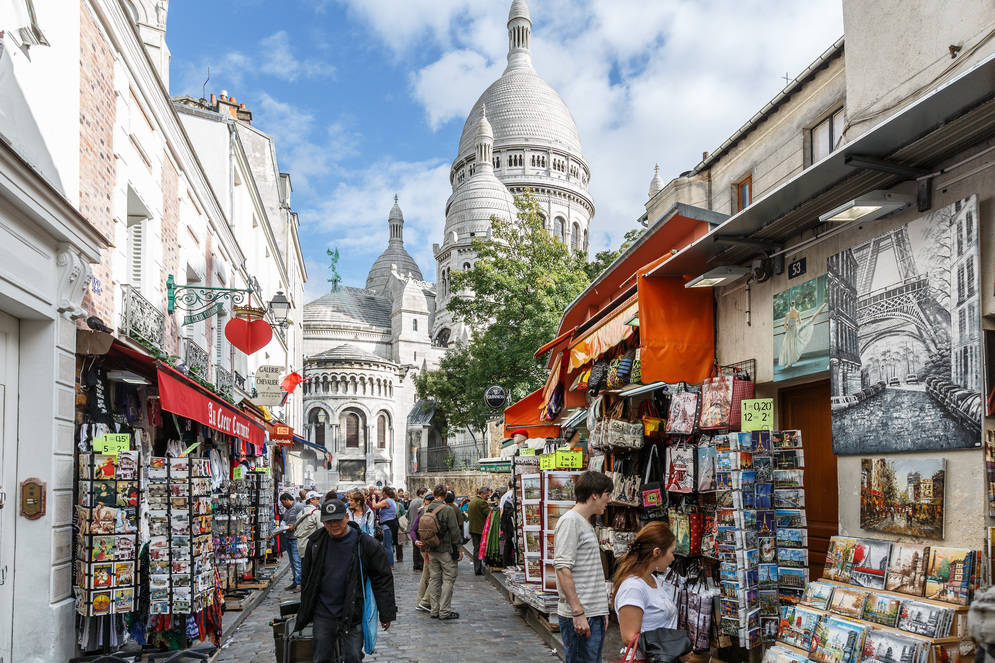
By the 19th century, the butte was famous for its cafés, guinguettes with public dancing, and cabarets. Le Chat Noir at 84 boulevard de Rochechouart was founded in 1881 by Rodolphe Salis, and became a popular haunt for writers and poets. The composer Eric Satie earned money by playing the piano there. The Moulin Rouge at 94 boulevard de Clichy was founded in 1889 by Joseph Oller and Charles Zidler; it became the birthplace of the French cancan.[9] Artists who performed in the cabarets of Montmartre included Yvette Guilbert, Marcelle Lender, Aristide Bruant, La Goulue, Georges Guibourg, Mistinguett, Fréhel, Jane Avril, Damia.
Artists gather
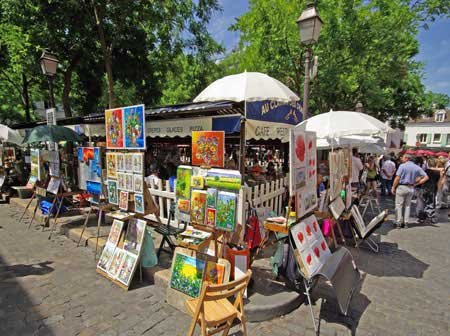
During the Belle Époque from 1872 to 1914, many notable artists lived and worked in Montmartre, where the rents were low and the atmosphere congenial. Pierre-Auguste Renoir rented space at 12 rue Cortot in 1876 to paint Bal du moulin de la Galette, showing a dance at Montmartre on a Sunday afternoon. Maurice Utrillo lived at the same address from 1906 to 1914, and Raoul Dufy shared an atelier there from 1901 to 1911. The building is now the Musée de Montmartre.[10] Pablo Picasso, Amedeo Modigliani and other artists lived and worked in a building called Le Bateau-Lavoir during the years 1904–1909, where Picasso painted one of his most important masterpieces, Les Demoiselles d'Avignon. Several noted composers, including Erik Satie, lived in the neighbourhood. Most of the artists left after the outbreak of World War I, the majority of them going to the Montparnasse quarter.
Among the last of the neighborhood’s bohemian gathering places was R-26, an artistic salon frequented by Josephine Baker, Le Corbusier and Django Reinhardt. Its name was immortalized by Reinhardt in his 1947 tribute song "R. vingt-six".
Contemporary Montmartre
There is a small vineyard in the Rue Saint-Vincent, which continues the tradition of wine production in the Île de France; it yields about 500 litres per year.
The Musée de Montmartre is in the house where the painters Maurice Utrillo and Suzanne Valadon lived and worked in second-floor studios. The house was Pierre-Auguste Renoir's first Montmartre address, and he painted several of his masterpieces there. Many other well known personalities moved through the premises. The mansion in the garden at the back is the oldest hotel on Montmartre, and one of its first owners was Claude de la Rose, a 17th-century actor known as Rosimond, who bought it in 1680. Claude de la Rose was the actor who replaced Molière, and who, like his predecessor, died on stage.
Nearby, day and night, tourists visit such sights as Place du Tertre and the cabaret du Lapin Agile, where the artists had worked and gathered. Many renowned artists, such as painter and sculptor Edgar Degas and film director François Truffaut, are buried in the Cimetière de Montmartre and the Cimetière Saint-Vincent. Near the top of the butte, Espace Dalí showcases surrealist artist Salvador Dalí's work.
Montmartre is an officially designated historic district with limited development allowed in order to maintain its historic character.
A funicular railway, the Funiculaire de Montmartre, operated by the RATP, ascends the hill from the south while the Montmartre bus circles the hill.
In "La Bohème", a 1965 song by singer-songwriter Charles Aznavour, a painter recalls his youthful years in a Montmartre that has, for him, ceased to exist: "I no longer recognize/Either the walls or the streets/That had seen my youth/At the top of a staircase/I look for my studio/Of which nothing survives/In its new décor/Montmartre seems sad/And the lilacs are dead'). The song is a farewell to what, according to Aznavour, were the last days of Montmartre as a site of bohemian activity.
Downhill to the southwest is the red-light district of Pigalle. That area is, today, largely known for a wide variety of stores specializing in instruments for rock music. There are also several concert halls, also used for rock music. The actual Moulin Rouge theatre is also in Pigalle, next to the Blanche métro station.
Source: https://en.wikipedia.org/wiki/Montmartre
Copying/Pasting full texts without adding anything original is frowned upon by the community.
Some tips to share content and add value:
Repeated copy/paste posts could be considered spam. Spam is discouraged by the community, and may result in action from the cheetah bot.
If you are actually the original author, please do reply to let us know!
More Info: Abuse Guide - 2017.
Downvoting a post can decrease pending rewards and make it less visible. Common reasons:
Submit
Wow looks like a very busy city with much to do and see great article...
Downvoting a post can decrease pending rewards and make it less visible. Common reasons:
Submit
Downvoting a post can decrease pending rewards and make it less visible. Common reasons:
Submit
wow Very Beautifull Photos 😍
good enjoy the travel 😍
Downvoting a post can decrease pending rewards and make it less visible. Common reasons:
Submit
Very beautiful city. Hope you are enjoying the christmas time and decoration there
Downvoting a post can decrease pending rewards and make it less visible. Common reasons:
Submit
this is a good old-fashioned story.
Downvoting a post can decrease pending rewards and make it less visible. Common reasons:
Submit
One day I have a dream to visit Paris !
Downvoting a post can decrease pending rewards and make it less visible. Common reasons:
Submit
Good content and very interesting. Thanks.
Downvoting a post can decrease pending rewards and make it less visible. Common reasons:
Submit
happy holiday
upvoted
Downvoting a post can decrease pending rewards and make it less visible. Common reasons:
Submit
Very nice post! Really beautiful city.
Downvoting a post can decrease pending rewards and make it less visible. Common reasons:
Submit
Good post my friend..
Downvoting a post can decrease pending rewards and make it less visible. Common reasons:
Submit
gallo romans... wow that is a looooong history... those roman streets stones are just incredible to have withstand time...looking at one random stone of them and knowing that someone, sometime in the past, centuries ago looked at that same stone, from the same view point and at the same hour of the day but for different reasons is just overwhelming...he/she didn't know I would write this on a pc and I will never know their faces...
Downvoting a post can decrease pending rewards and make it less visible. Common reasons:
Submit
Good job my friend..
Downvoting a post can decrease pending rewards and make it less visible. Common reasons:
Submit
my dream city is Paris
Downvoting a post can decrease pending rewards and make it less visible. Common reasons:
Submit
paris is the very beautiful place, i love paris
Downvoting a post can decrease pending rewards and make it less visible. Common reasons:
Submit
Great post @lndesta120282, followed for more! I absolutely love Paris!
Downvoting a post can decrease pending rewards and make it less visible. Common reasons:
Submit
Paris is the #1 place in Europe that my wife would like to visit. For me though, I'd rather see Greece, Italy or Spain.
Downvoting a post can decrease pending rewards and make it less visible. Common reasons:
Submit
Nice
Downvoting a post can decrease pending rewards and make it less visible. Common reasons:
Submit
Looks amazing. Can’t wait to go
Downvoting a post can decrease pending rewards and make it less visible. Common reasons:
Submit
WoW ! the awesome city Paris
I wish visit paris
Bon courage @indesta120282
Downvoting a post can decrease pending rewards and make it less visible. Common reasons:
Submit